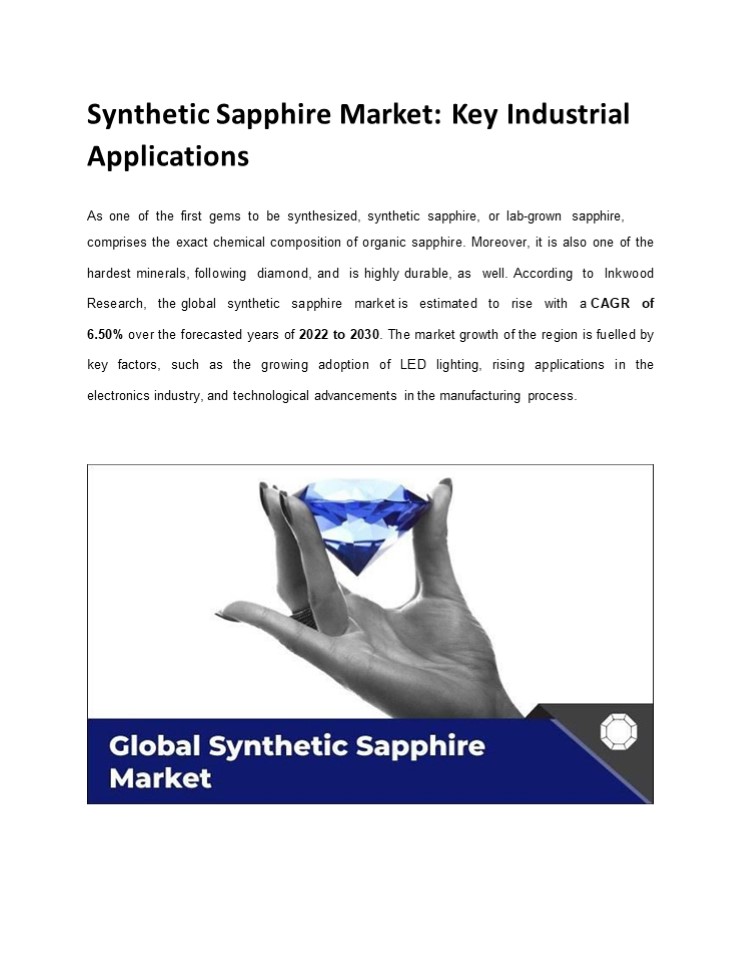Synthetic Sapphire Market: Key Industrial Applications
Title:
Synthetic Sapphire Market: Key Industrial Applications
Description:
As one of the first gems to be synthesized, synthetic sapphire, or lab-grown sapphire, comprises the exact chemical composition of organic sapphire. Read More. –
Number of Views:0
Title: Synthetic Sapphire Market: Key Industrial Applications
1
Synthetic Sapphire Market Key Industrial
Applications
As one of the first gems to be
synthesized, synthetic sapphire, or lab-grown
sapphire, comprises the exact chemical
composition of organic sapphire. Moreover, it is
also one of the hardest minerals, following
diamond, and is highly durable, as well.
According to Inkwood Research, the global
synthetic sapphire market is estimated to
rise with a CAGR of 6.50 over the
forecasted years of 2022 to 2030. The market
growth of the region is fuelled by key factors,
such as the growing adoption of LED
lighting, rising applications in the
electronics industry, and technological
advancements in the manufacturing process.
2
Synthetic Sapphire Market A Detailed Look at
Industrial Applications On account of its
excellent properties, sapphire is utilized in
several industrial products and applications. For
instance, owing to the materials high scratch
resistance, transparency, and hardness, synthetic
sapphire is often utilized in ball bearings and
wristwatches. Over recent years, the material
has also found widespread usage in
fingerprint authentication sensors and
smartphone lens covers.
- Aligning with this, some of the top applications
of synthetic sapphire are as follows - Sapphire Substrates
- Sapphire is characterized by exceptional
electrical insulation, good thermal
conductivity, transparency, as well as high
rigidity properties. As a result, it is a
preferred material for substrates and
is thus utilized in LED as well as
microelectronic circuits and ultra-high-speed
integrated circuits. - Sapphire substrates also play a significant role
in the production of several other electronic
devices, owing to their remarkable electrical
properties. - Consumer Electronics
- The expansion of the consumer electronics
industry is expected to provide synthetic
sapphire manufacturers with lucrative growth
opportunities. This is primarily accredited
to the materials growing demand for the
production of smartphones, camera lenses, and
watches, among other devices. - Moreover, the use of synthetic sapphire as a
scratch-resistant material further drives the
growth of the consumer electronics segment as a
key end-user. - Display
- Sapphire has been used as a covering for
cellphone camera lenses, in addition to being
tested by manufacturers of electronic tablets
for shatter-proof display screens. - Furthermore, sapphire glass is also ideal for
display devices subject to significant wear and
tear, like smartwatches and fitness trackers. - Optical
- Since sapphire is radiolucent (transparent to
X-rays), it is ideal for use in MRI, CT, and
various other intraoperative imaging procedures.
In addition to resulting
3
- in clear imagery, the use of synthetic sapphire
in optical applications also enables enhanced
diagnostic capability. Furthermore, the
materials thermal conductivity facilitates
enhanced cooling, predominantly for laser
procedures. - Synthetic sapphire windows are also utilized on a
large scale as they are stronger - compared to standard glass windows.
- Accordingly, as per Inkwood Researchs
analysis, the optical segment is projected
to dominate the application category during the
forecast years. - Synthetic sapphire is also largely used in the
medical sector for a varied range of
applications. - These include endoscope lens covers,
scalpels, hematology inspection filters, as
well as - medical plunger pump parts. Furthermore, the
adoption of synthetic sapphire in emerging
regions of the Asia-Pacific, such as Thailand,
India, and China, is set to rise rapidly over the
upcoming years, predominantly on account
of the increase in new construction and - infrastructure activities.
Top Trend Government Guidelines Encourage
Synthetic Gems Production The manufacturing
process of synthetic sapphire is less polluting
and environmentally friendly compared to the
production of various alternative materials.
Moreover, the material comprises minimal
contamination, with negligible defects and grain
boundaries, thus providing synthetic sapphire
with a wide range of desirable properties.
Accordingly, governments of developing economies,
such as India, are considering the propositions
of the jewelry industry with a view to promoting
manufacturing and exports. These predominantly
include facilitating shipments through e-commerce
and establishing common facility centers. For
instance, as per the Gem Jewellery Export
Promotion Council (GJEPC), Indias government
separated the Indian Trade Clarification
(ITC) code for rough synthetic
gemstones into non-diamonds and diamonds.
The initiative is expected to enable
4
organizations to monitor the exact quantities of
lab-grown diamonds brought into the jewelry
industry, thereby encouraging their wide-scale
manufacture. As a result, these factors
are expected to contribute to the overall growth
of the global synthetic sapphire market during
the forecast years.
By Shruti Vanjare
FAQs What are some of the key companies
operating in the global synthetic sapphire
market? Juropol Sp ZOO, Iljin Display Co Ltd,
Namiki Precision Jewel Co Ltd, Crystalwise
Technology Inc, and others are among the key
companies operating in the global
synthetic sapphire market.
What are the top factors driving the Asia-Pacific
synthetic sapphire markets dynamic growth? The
growth of the regions medical as well as
consumer electronics industry, rapid construction
activities and infrastructural development, as
well as the rising demand for LED products, are
set to drive the dynamic growth of the
Asia-Pacific synthetic sapphire market.































